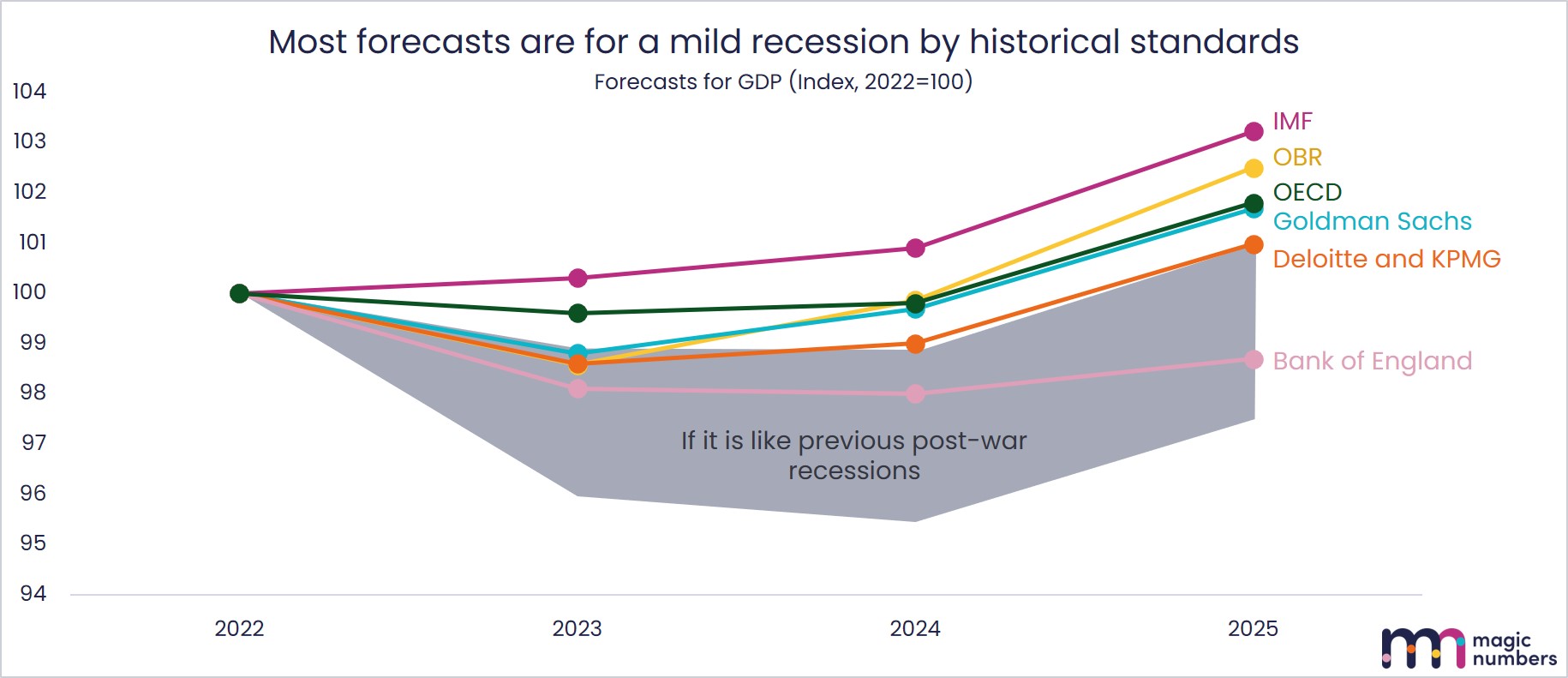The chart above shows trajectories for UK GDP, benchmarking 2022 to 100. The grey zone has been constructed by supposing that the coming recession will be like previous post war recessions, and all the colourful lines are forecasts.
The IMF – in dark pink – think there won’t be a recession at all, the economy will just grow a little slower. And, at the other end, the Bank of England thinks things might be as bad as the recession in the 1980s.
But, in the middle, the majority have come to broadly the same conclusion. There will be a recession, but it won’t be too bad.
These analysts are factoring in all the downsides: energy and food prices going up, central banks raising interest rates and affecting what we pay on our mortgages, and the health hangovers from COVID-19.
But they are also weighing up sources of resilience:
- People who were forced to stay home a lot over the last few years and so spent less and saved more. They have a cushion and can still afford some luxuries.
- A global financial system which is in a good state because banks and governments learned the lessons of the global financial crisis.
- Businesses that survived COVID-19, perhaps because their model is strong, or they were agile and able to evolve. These are firms that will likely survive again.
Taking both positives and negatives into consideration, most net out at a recession that won’t be too painful.
Risks and opportunities in campaign planning
This is not to say that marketers can relax. There are some important moves to make.
First and most important, is to get messaging right. It’s because there’s an opportunity to help the CFO with his or her biggest problem, but also a risk of saying the wrong thing.
With salaries for employees and the cost of materials going up. CFOs are wondering to what extent they can charge more. Remaining profitable means increasing price but how many customers will leave? A high profit margin on a lost sale still means zero profits.
Marketing and advertising can help. Customers will continue to buy even at a higher price if they believe the product is worth the money. Perceptions don’t change overnight, but they do move, and communicating your quality or value claim is more important than ever.
It’s important to do this in a way that recognises how polarising the pandemic was financially. Some people came out of it in a really very precarious position and are now choosing between heating and eating. But others actually came out better off.
Targeting media buys to different groups so that you can use different messaging is one option. Another is to craft a tone of voice and message that works for everyone.
Scenario planning
Futurists very rarely talk about one forecast, one future. Instead, they look at a range of ways relevant things might evolve and identify routes forward that work in all possible futures.
When the world is as uncertain as it currently is, this is a sage way for businesses to operate too. CMOs and senior marketers should be using numbers, research, and spreadsheets to work out the likely outcome of different marketing plans in different futures.
It’s possible to adapt share of voice, share of market frameworks to recession planning by looking at different marketing plans and different scenarios for what competitors will do. The resulting market share trajectory can be combined with forecasts of how big your category will be, to get a figure for the value of that extra or lost market share.
Even better, a solid econometric analysis will not only give you a read on advertising effectiveness, but also an estimate of what will happen if and when you put your price up. Good providers build forward looking tools that embed forecasts for economic variables that matter to your specific business and allow you to tweak all elements of the marketing mix.
The resulting set of scenarios then forms a road map for the changing world, a route out of the endless cycle of planning and re-planning we all went through during COVID. Because when situations shift, it’s to a version you’ve already considered or can easily evaluate using the framework
A crystal ball is too much to hope for, but it is possible to write yourself a manual, or better still, a friendly guide book.


